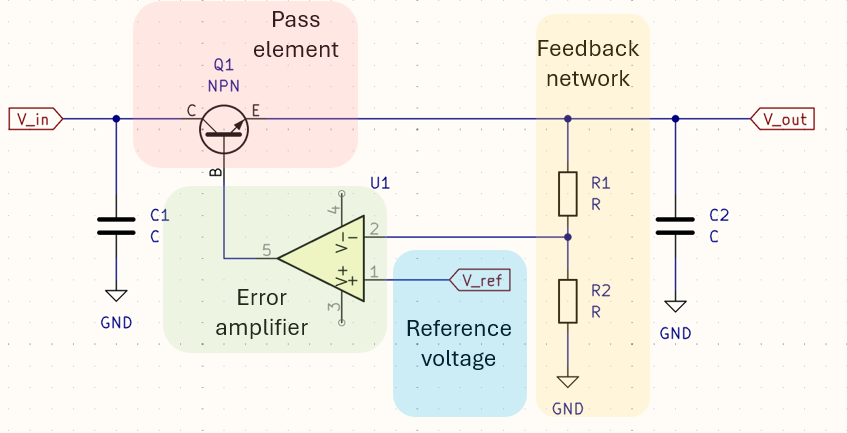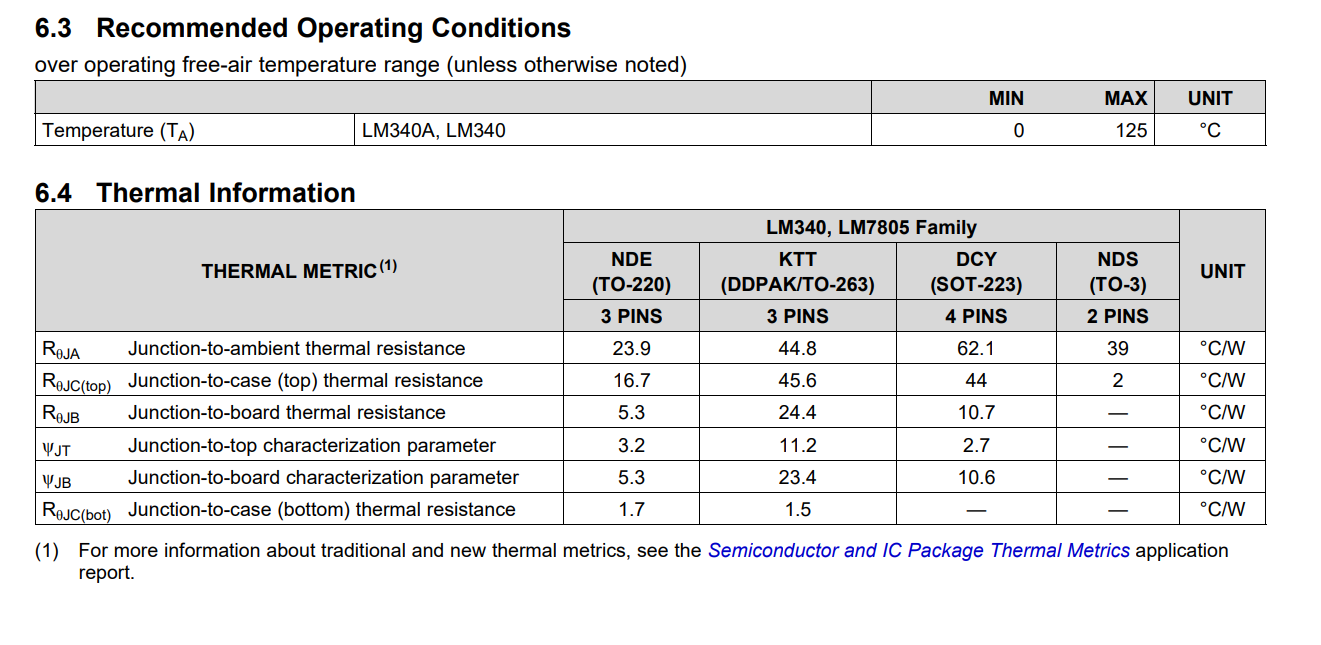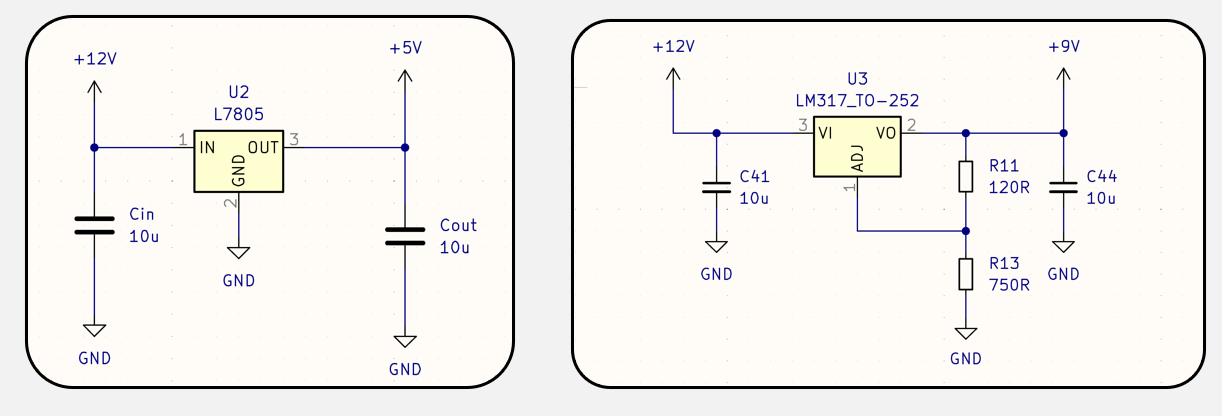Linear regulators are one of the most famous and simple types of voltage regulators used in electronics. In this article, I will go into the basics of linear regulators as well as low dropout regulators (LDOs), how to use them, pros and cons, and more.
Table of contents
Video tutorial
First, watch the complete video tutorial and use the written article as a reference.
What is a linear regulator?
A linear regulator (and LDOs) is a device that takes an input voltage and delivers an constant stable output voltage which is lower than the input voltage during all load conditions.
Internally, the linear regulator has basic building blocks or components which allows it to regulate, they are:
1- Series pass element.
2- Error amplifier.
3- Feedback network.
4- Reference voltage.

By the work of these fundamental building blocks, the linear regulator achieves its task of regulating the output voltage.
How does linear regulator works?
The series pass element is a transistor, can be NPN or Darlington NPN or even a PNP, can also be a MOSFET.
The error amplifier takes the output feedback signal from the feedback resistors, compares it to the internal reference voltage, then send proper driving signal to the pass element’s gate/base in order for the pass element to adjust its resistance to maintain a constant output voltage.
So, the series pass element acts as a variable resistor in linear regulators. Meaning, it works in its “linear region”, hence the name “linear regulator”. Linear region of operation in transistors are sometimes called “Ohmic region” or “active region” in BJTs.
Since it works similar to a variable resistor then it must burn the excess power as heat, which is the most important aspect you should pay attention to. It is directly related to an important term called “dropout voltage“.
Dropout voltage vs Heat dissipation
Dropout voltage = Input voltage – Output voltage.
For example, 12v input and 5v output is going to result into 7v of dropout. Why is it important anyway?
For a load of say 1 amps, the 7v dropout across the linear regulator’s internal pass element will result in 7 watts of power dissipation, which is very big. This amount of dissipated power will result into a lot of heat which may destroy the regulator all together!
Therefore, for linear regulators, the designer must make sure the heat dissipation is within healthy conditions as will be explained further in this article.
Dropout voltage vs output voltage regulation
Besides heat generation explained above, dropout plays a significant role in regulation.
When you read in a linear regulator datasheet that its dropout voltage is 2v for example, it means that in order to regulate properly for up to full load, it needs at least 2v of dropout between input and output.
For example, if you use a regulator for 5v output which has 3v dropout, you would need at least 8v of input voltage.
What if I made the dropout higher than the minimum dropout? the regulation will be fine but heat generation will increase linearly with increased dropout (assuming everything else is the same), hence another reason for calling it linear regulator.
It is worth mentioning that dropout voltage is often specified at full load and at a certain temperature, one must see the datasheet for the specific IC he wants to use to make sure of the correct value.
However, designers often use the maximum dropout specified at full load when they design their circuit, which is a good practice to follow. Never design on absolute margins.
What is a low dropout regulator (LDO)?
It is a linear regulator but with very low dropout voltage. All mentioned stuff about “standard” linear regulator apply for LDO, with very few things to take into consideration.
An LDO has an internal pass element which is does not require a big dropout to work, namely a PNP or a MOSFET.
However, stability of LDOs is more critical than standard linear regulators, especially the amount of capacitance at inputs and outputs, as well as the types of capacitor used. Datasheet for the specific part you want to use is the best way to know which capacitor type to use and how much is good value.
Some LDOs can get to an ultra low dropout voltage of 100mv at full load of 2 or more amps, which is very good. These can be powered with a switching regulator of say 5.1v in order to deliver 5v with low to pretty much no added heat, all of this with the added benefit of noise reduction and excellent transient response.
How low it needs to go to become an LDO? well, no rule here but common agreement that it is about 1v. Practically, designers aim for less than 1v to use linear regulators unless current is very low.
Thermal management
Heat is generated at the junction due to the nature of linear regulators. This heat will move from junction to the outside or even through the case itself to a heatsink if applied.
How smooth or how well this heat moves is called thermal resistance. Meaning, if thermal resistance is low, the heat will transfer better. If it is high, then some heat will not transfer which results in raising the temperature of the junction and the device itself. Thermal resistance is specified in degrees C per Watts.
Junction-to-ambient thermal resistance: it is the resistance heat will face when generated in the junction itself and wants to move to the outside air. The lower, the better and more efficient. meaning with low thermal resistance, heat will transfer better (more efficient) to the outside.
Junction-to-case thermal resistance: how heat transfers from the junction to the package itself. Usually, this is used to estimate the case temperature especially when a heatsink is attached.
Junction-to-board thermal resistance: how heat transfers from junction to the PCB itself, using a thermal pad of the package. Not all linear regulators offer this kind of package which means you will not find this thermal resistance specified in its datasheet.
Junction-to-top characterization parameter: can be used to estimate the temperature at the center top of the package using EVB standard (different than those mentioned above). Usually, they do an actual measurement of the heat at the top of the case then use this parameter to determine junction temperature. A similar parameter can be used for bottom of the case too.
This parameter in my opinion is more accurate than junction-to-case since for the later to be accurate, we need to use the partial power which uses that path not the total power dissipated in the device. This is very hard to determine, but for characterization parameter, it uses the total dissipated power regardless if there are other thermal paths or not.
Example 1: a linear regulator without heatsink, has thermal resistance of 30 degrees C/W, runs at 600 mA with dropout of 2 V, assume ambient temperature is 25 degrees. What is the thermal performance of it?
Dissipated power = 2 x 0.6 = 1.2 W.
Junction temperature raise = 30 x 1.2 = 36 degrees.
Junction temperature = 36 + 25 = 61 degrees.
Therefore, the junction runs at 61 degrees and assuming 125 degrees maximum, the device will work fine. However, 61 is a bit high and will heat up nearby components. If this is a concern, a better device should be used.
Another solution is to check the datasheet if it offers a package which has thermal pad and use it. Layout the board with this pad attached to huge copper pour with lots of direct and close-by vias which will help dissipate the excess heat inside the copper pour which will reduce overall temperature.
Example 2: 7805 regulator running at 300 mA from 12 V source. Will it run ok?
7805 from TI delivers 5 V which means a dropout of 7 V, dissipated power is 2.1 W. Here are the junction temperatures for each package it offers (page 4):

TO-220: 75.19 degrees
DDPAK/TO-263: 94.08 degrees.
SOT-223: 130.41 degrees.
TO-3: 81.9 degrees.
Thus, we see that TO-220 package offers the best thermal performance while SOT-223 not only the worst performance but the device itself will be destroyed as the junction temperature exceeds the maximum specified.
However, if we want to use the board copper pour as a heatsink, we have TO-220 and DDPAK packages offering a nice option. By soldering the package pad to the board, now we use junction-to-board thermal resistance to calculate junction temperature. It will be like this:
TO-220: 36.13 degrees.
DDPAK/TO-263: 47.47 degrees.
Now this is significantly better for the junction, but the excess heat is now transferred to the board. Depending on the copper pour size, number of layers, number of vias, and placement of vias (called thermal vias here) etc… the final board temperature can be determined. Basically, the bigger the pour and more vias, the better heat is managed. Putting multiple vias directly in the component thermal pad footprint itself can also significantly boost the performance.
Yet, if you choose to have a heatsink at the top, heat in junction can be further reduced as now it will have 2 paths to move: first to the board copper pour itself, then to the heatsink through the device’s package itself which will use junction-to-case thermal resistance.
Overall, if you have lots of heat and consider using heatsinks and so on, then probably it is best to not use the linear regulator and go to an efficient switching regulator.
Example 3: what is the case estimated temperature of example 2 when using DDPAK package using EVB standard?
Case temperature = junction temperature – (junction-to-top characterization parameter x dissipated power).
Case temperature = 94.08 – (11.2*2.1) = 94.08 – 23.52 = 70.56 degrees.
This means that the case will be very hot if the heat is not transferred elsewhere.
Commercially available regulators
Basically, they are fixed or adjustable regulators. Both have the same components and building blocks except that the fixed version have the feedback resistors inside the package itself and hence it cannot be changed. Everything else is the same, like thermal calculations and so on.

If you need a standard voltage like 5v or 3.3v then get a fixed one which will save you space, but if there are multiple rails with other voltages then it makes sense to get one adjustable regulator for all of them and just change the feedback resistors as needed.
Pros and Cons of linear regulators
Here is a basic table for it:
| Advantages | Disadvantages |
| Low noise output. | Generates heat (low efficiency). |
| Simple to design and layout. | Steps down the voltage but not up. |
| Small number of parts. | |
| Low price. | |
| Made by many manufacturers. |
So when to use a linear or LDO regulator and when not to?
If you need very low current consumption which won’t generate heat then get a linear regulator or LDO. If you make sure that there won’t be excessive heat generation then use a linear regulator. Having very low noise to power noise sensitive parts like ADC is a good reason to have an LDO.
However, if you need a heatsink to run the regulator correctly then do not use a linear regulator since it is not worth it, a switching one designed correctly is a better choice.
Layout
Layout for linear regulator is not as critical as it is for switching regulators, but it is always nice to do the right thing.
All you need to do is put the input capacitors and output capacitors very close to their respective pins, and have short path to ground.
Put ground vias near ground pins of the regulator and ground pads of the caps. Also, use big ground pour to connect them instead of traces.
Copper pours can also be used for input and output power paths too. You can use multiple vias to share heat which is a very good practice.

